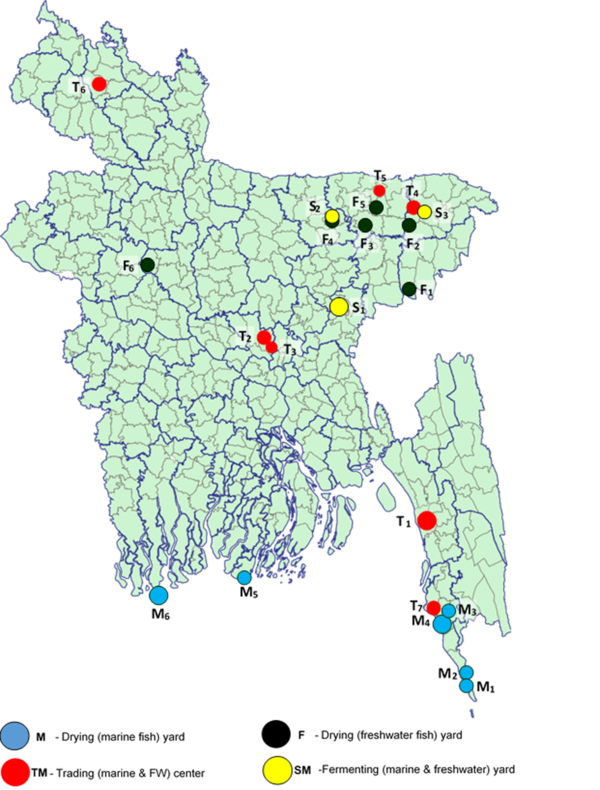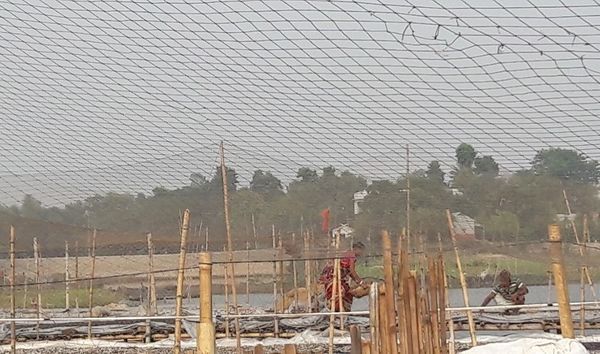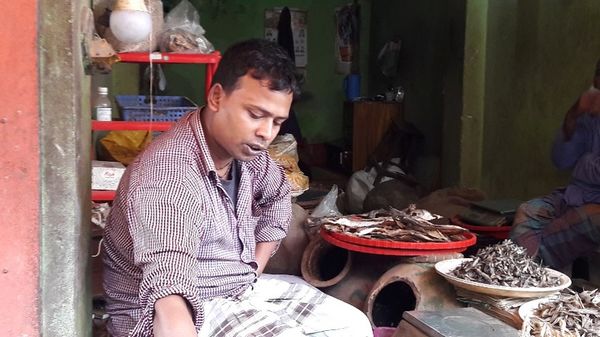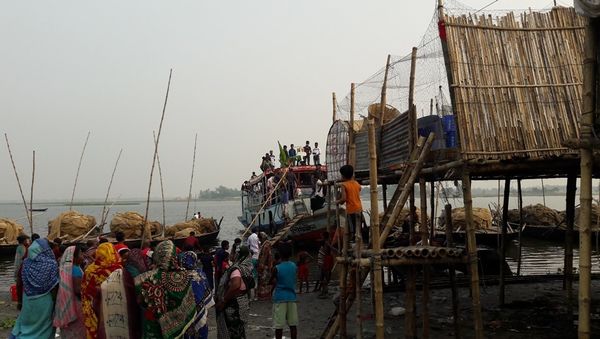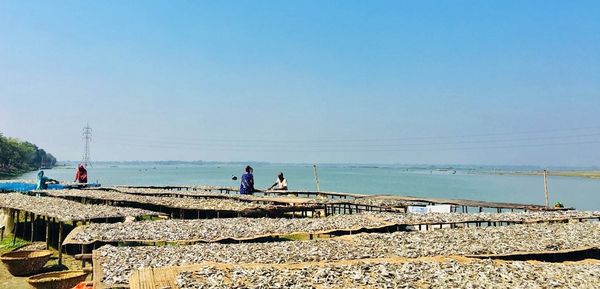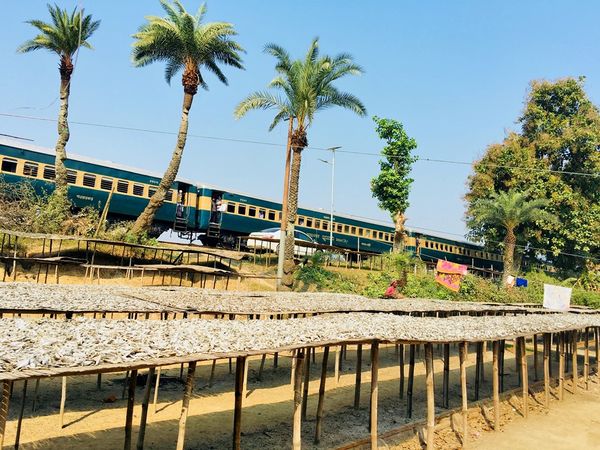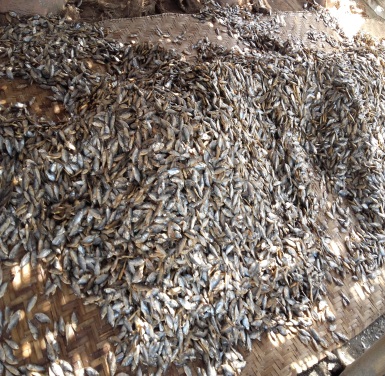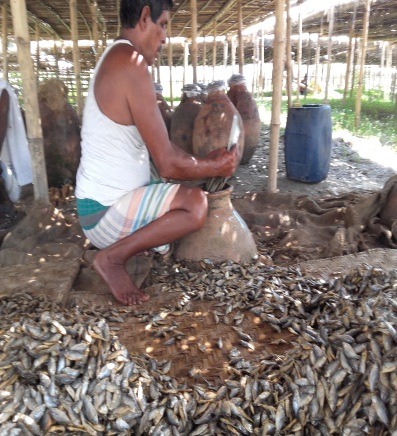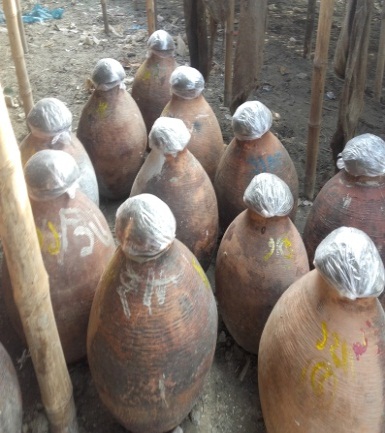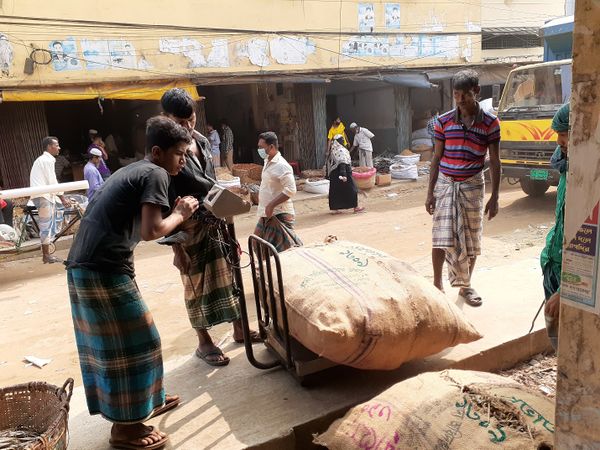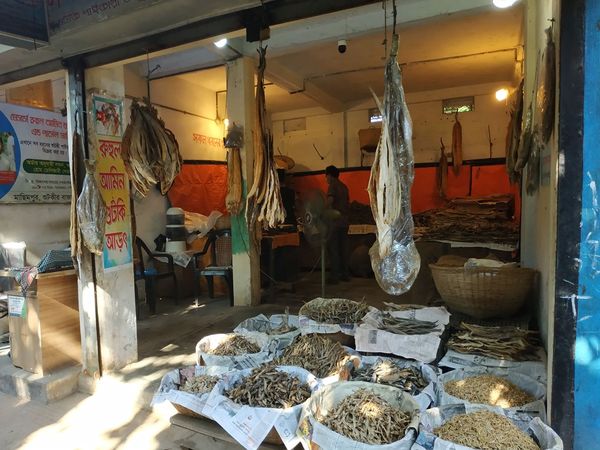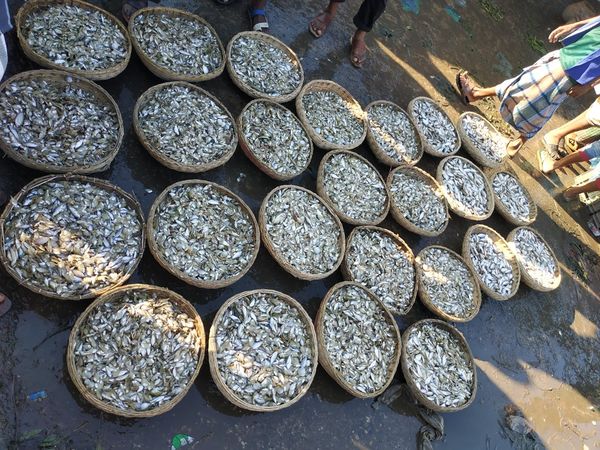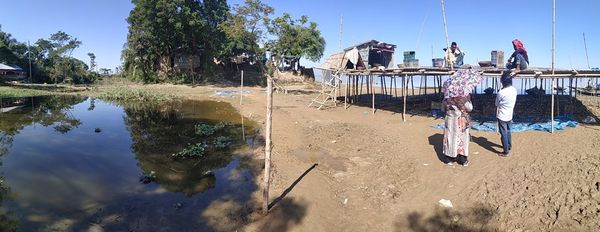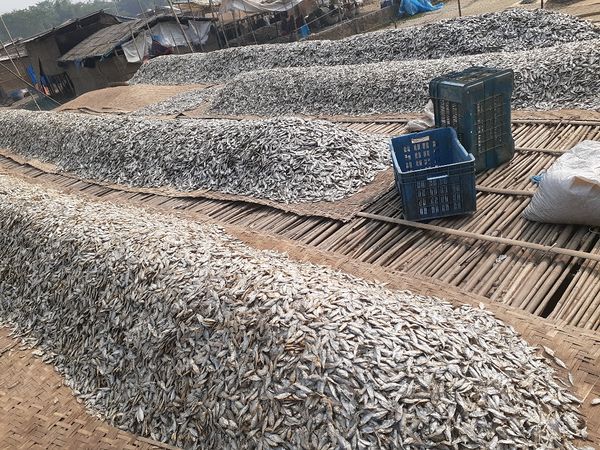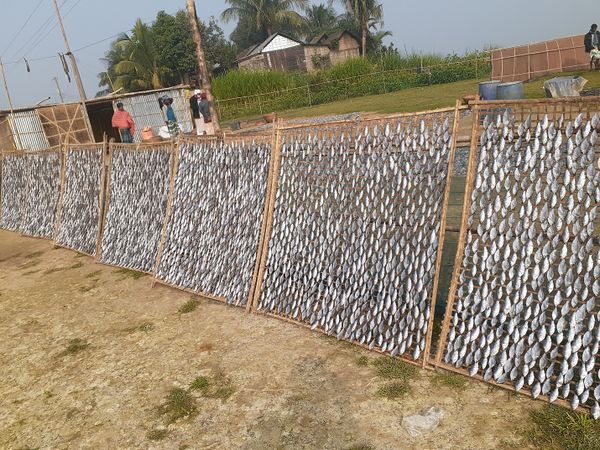Key locations: Dry Fish processing and trading in Bangladesh
Introduction
The dried fish sector has made a strong position in the economy of Bangladesh as it has its appearance both on international and local markets. The large-scale fish drying and fermentation activities are concentrated in Chittagong, Cox’s Bazar, Sylhet-Mymensingh-Comilla and Khulna-Barisal-Patuakhali region (Table 1 & Fig. 1). Dublar Char in Sundarban, Khulna, and Nazirar Tek and Sonadia in Cox’s Bazar are the major and largest marine fish drying facilities of the country. Freshwater fish are mainly dried in Sylhet-Mymensingh-Comilla region. In the Chalan Beel area at the north central Bangladesh, in Faridpur and Kaptai Lake, smaller quantity of freshwater fishes is dried as well.
It is estimated that half of the total marine catch and nearly 4.0% of freshwater catch is dried (Hossain et al., 2015). Fish drying goes on round the year with the substantial production during October to April and, marketed both in domestic and international markets. These dried fishes have high demand both in domestic and international markets. In the dry fish value chain, producers have no or very little influence over marketing and supply, rather they are strongly managed and monopolized by giant traders, brokers, as well as giant super market companies, whose intervention results in price distortion in domestic market and, thereby, erodes profitability and preference of primary producers. The key locations in the dried fish sector in Bangladesh can be divided into four categories –
- Drying (marine fish) yard,
- Drying (freshwater) yard,
- Fermenting (marine & freshwater) yard, and
- Trading (marine & freshwater) center.
| Zone | Name of dry fish processing center/market | Type of market/landing center | Fish type | Stakeholders | Activities |
|---|---|---|---|---|---|
| Greater Mymensingh | Arogdia, Mohonganj, Netrokona (F4) | Processing Yard (Dungery) | FW | Dungery owners, processors, labourers, Middlemen | Drying |
| Kuliarchar (F4) (S2) | Dry fish & fermented fish Processing Yard) | FW, M Punti-Phaisa | Dungery owners, processors, labours, Middle men | Drying, trading, Fermented fish processing | |
| Chittagong Cox’s Bazar | Nazirar Tek (Kutubdia Para) (M4) | Processing Yard (Khola) | M | Khola owners, processors, labours, Middlemen | Drying & trading |
| Laboni Beach & adjacent tourist areas, Cox’s Bazar (T7) | Trade center (Shutki Bazar) | M | Retailers | Trading | |
| Sonadia Island, Moheshkhali, Cox’s Bazar (M3) | Processing Yard (Khola) | M | Khola owners, processors, labours, Middle men | Drying, trading | |
| Hospital gate, Jele para, Teknaf (M2) | Processing Yard (Khola) | M | Khola owners, processors, labours, Middle men | Drying, trading | |
| Primary school, Chowdhury para, Teknaf (M1) | Processing Yard (Khola) | M | Khola owners, processors, labours, Middle men | Drying, | |
| Asodgonj, Chittagonj (T1) | Trade center (Shutki Bazar) | M | Wholesaler, Middlemen, retailer | Trading | |
| Brahmanbaria | Lalpur (S1) | Fermentation & Drying Yard (Dungery) | FW, M Punti-Phaisa | Khola owners, processors, labours, Middle men | Fermented fish processing, drying & trading |
| Dhaka | Karwan Bazar & Rayer Bazar (T2) | Trade center (Shutki Bazar) | M | Wholesaler, Middlemen, retailer | trading |
| Zatrabari (T3) | Trade center (Shutki Bazar) | M | Wholesaler, Middlemen, retailer | trading | |
| Greater Sylhet | Lambabag, Chelaria, Nazir Nagar, Derai, Sunamgonj (F3)(T5) | Riverside Processing Yard (Dungery) | FW | Dry fish Processor | Drying |
| Bishwanath (F2) | Dungery | FW | Dry fish Processor | Drying | |
| Srimanganj (F1) | Dungery | FW | Dry fish Processor | Drying | |
| Noapara and Murdapur, Sunamgonj (F5) | Dungery | FW | Dry fish Processor | Drying | |
| Massimpur (T4)(S3) | Trade center, Fish fermenting (Shutki Bazar) | FM | Wholesaler, Middlemen, retailer | trading | |
| Greater Barisal- Patuakhali | PoschimKuakata, Khalgura under Lata chapli Union Kolapara (M5) | Processing Yard (Khola) Wholesale market (Shutki Bazar) | M | Dry fish Processor Dry fish wholesaler Middlemen | Drying, trading |
| Khulna- Sundarban | Dublarchar – several chars – Alorkole, Shalarchors, Meher Ali, Majherkilla (M6) | Processing Yard (Khola) Wholesale market (Shutki Bazar) | M | Dry fish Processor Dry fish wholesaler Middlemen | Drying, trading |
| North Bengal | Chalan Beel, Pabna, Sirajgong (F6) | Roadside Processing Yard (Dungery) | FW | Dry fish Processor | Drying |
| Syedpur, Nilphamari (T6) | Trade center (Shutki Bazar) | FM | Wholesaler, Middlemen, retailer | trading |
Drying (marine fish) yard
There are numerous drying sites for marine finfish and shellfish located in the coastal belt of Bangladesh. Marine drying operations are referred to as khola or kila. Kholas are often shifted based on raw material availability, accessibility, landing facilities, and other physical conveniences. The major marine fish drying sites are located in the District of Cox’s Bazar in two upazilas namely Cox’s Bazar Sadar and Teknaf.
The drying season varies slightly from site to site. The largest marine fish drying site presently in operation (Nazirar Tek in Cox’s Bazar Sadar) is run for eight months/year from mid-August until mid-April. However in Sonadia Island operations run from mid-August until mid-March. In Teknaf, fish drying sites are operated for eight months from mid-August to mid-April, however, drying is possible here in the remaining four months of the year, although the product is of much lesser quantity.
Nazirar Tek
Any newly emerged triangular shaped island is known as ‘tek’ in Cox’s Bazar. Nazirartek was named after Nazir Ali from Cox’s Bazar who died in 1960 while fishing with a cast net. His body was found and the place was named after him.
Nazirartek is the largest fish drying center of Bangladesh which is located at the mouth of the Bhakkali River under Cox’s Bazar District. This drying yard is basically a coastal sand bed, located 3 km away from Cox’s Bazar city and by the side of the Bay of Bengal. The fish drying center is nearly thirty years old. Before the establishment of this fish yard, this place was a deserted sand bed. In 1987, at first, fishing communities of Kutubdia, a sub-district of Cox’s Bazar, were granted formal permission to settle in this location, after being displaced by severe coastal erosion. These in-migrants established fish drying activities in the new settlement. A second wave of in-migration from Kutubdia occurred in 1991, in the aftermath of a devastating cyclone. Currently, there is a part of the settlement named ‘Kutubdia Para’ where most of the former residents of Kutubdia live. The whole of Kutubdia para including shutki mohal of Nazirartek is under Ward 1 of Cox’s bazaar Municipality. The land is owned by government. During the Ershad regime, people from Kutubdia came here – in 1985-1986 and formed a landless group (Bastuhara Samity) and occupied the land. Kutubdia Para is located in the mouth of the Bankkhali River on the Bay of Bengal and was close to Cox’s Bazar town and good for fishing, so they decided it would be a good place to relocate. The number of permanently settled households has grown to around 7000, most of which possess at least one to two members involved in fish drying activities, for a total permanent population involved in fish drying is around 12,000 at Nazirartek dry fish center.
Kutubdia Para covers an area of 682 acres. There are 784 registered members of the kholaowners association (samity), though the total number of khola is 2200, all khola owners are not registered. The average size of khola is near to half a kani (1 kani = 20 gonda equivalent to 40 decimals or 0.4 acre). The total dried fish processing facility where kholas are located is 130 acres. The number of khola in Nazirartek is increasing every year. About 15 new khola opened in Nazirartek in 2014. The mean area of khola was found to be 17 dec.
Wet fish come from the landing center (ghat) down the Nazirartek fish drying facility. Saudagars (khola owners) go to the boat to see what quantity of fish is available, and bargain over the price. There is an open auction at the trawler. Some khola owners have their own trawlers, but the majority do not.
Teknaf, Cox’s Bazar
Teknaf Upazila is located 80 kilometers south of Cox’s Bazar city. This is a small sub-district of Cox’s Bazar situated by the bank of river Naaf. Naaf river was one of the most important sources of fishing and fish transportation routes. But due to massive Rohinga influx in 2017 and Yaba smuggling through Naaf river, Government of Bangladesh has banned fishing and river transportation through Naf river. As a result, fishers dependent on Naaf river fishing and adjacent dry fish yards have been reduced in the last 4/5 years. Generally, fish drying activities start in August in full swing and slowdown from April at Teknaf. Limited field observation in Jalipara suggest that there is no formal educational institution in Jalipara. The mentionable establishment includes one mosque and one NGO. Due to the sudden loss of livelihood, fishers nowadays are working as day labourers. The number of people involved in formal labor market is very low.
Dublar Char
Presently, fish are dried mainly in the four islands of Dublar Char – the main and largest island – Alorkol and three islands namely - Meher Ali, MajherKilla and Office Killa. The smaller scale drying operation takes palce in Narikel Bari (between Shelar Char and Office Killa) and Shelas Char, which is NE of Office Killa.
Alorkol
AlorKol is the biggest drying site. There are about 800 boats in AlorKol. All of the khola operators on Alorkol have their own boats numbering 1-4. If one khola owns a boat there will be 5-6 people working on the boat, and 5-6 working in the khola. If the khola has 2 boats the numbers will double. The population of Alorkol is nearly 10,000.
Meher Ali, Majher Killa and Office Killa
There were 15-20 khola in Meher Ali in the past. In Office Killa there are 18-20 khola. In Majher Killa there are 8 khola. The khola owned by the people from Bagerhat and Pirojpur are small (e.g. 20 x 50 feet) and produce 100-150 maund (40 kg equivalent to 1 maund) of dried fish and 20 maund of trash fish per year. Large kholas here owned by people from Chittagong are 300 x 500 feet and produce 1000-1200 maund of dried fish and 50 maund of trash fish per season.
Drying (freshwater) yard
The main freshwater fish drying sites in Bangladesh are located in the Northeastern haor basin: a floodplain area containing numerous natural water bodies, which is deeply flooded each monsoon season. Some production also takes place in another large natural depression, Chalan Beel, in the lower northwestern region. The largest single drying site is located in Kuliarchar, in Krishoreganj district, where there are more than 80 large drying operations. Drying operations elsewhere tend to be more widely spread, in small clusters of 4-6 operations in a single village.
There are two main types of fish drying infrastructure. In flood prone areas, fish are dried on platforms constructed of bamboo and jute sticks and raised several meters off the ground. These are called dangi or dangery, and are usually covered with netting to prevent birds taking fish. At the beginning of the drying season fish is processed on the platform, but as flood waters recede, processing takes place in the shade underneath. Fish are dried either on the platform itself, or attached to loosely woven mats which are propped up around the sides of the platform. Fish may also be dried on woven mats placed on the ground below the platform in order to expand capacity. In other areas, fish are simply dried on mats on the ground, inside small fenced enclosures called khola. Many drying operations are household enterprises, to which the operators and their families contribute their own labour. Some khola or dangi owners operate additional complementary businesses, such as trading dried fish, or are members of fishers associations with access rights to water bodies.
Kuliar Char
Kuliarchar is an Upazila of Kishoreganj District in the Division of Dhaka, Bangladesh. It is located at 24.1542° N 90.9000° E. It has 26,143 units of house hold and a total area 104.01 km². The Upazila has 7 Unions/Wards, 46 Mauzas/Mahallas, and 131villages. Though the catch from inland fishery has decreased substantially over the years (due to various factors including use of pesticides in the agriculture), the Upazila still receives good catch from several haors.
Dried fish production has been going on in Kuliarchar for as long as people can remember, but now the processors are more skilled than in the past and can do things more quickly. The fish drying units are located in the Das Para by the launch ghat of the Kali River. According to a retired school teacher from the community, the locality is inhabited for at least two hundred years by the Koibarta, Das and Barman people, two Hindu castes particular known for their livelihood from rivers and fishing.
During 2019-20, there were 28 dangi (fish drying units) owned 24 owners in Das para. But the number changed every year depending on forecasts. 2020 being a bad year for business meant people were less enthusiastic to invest for the next year. On average, area of a dangi is 5.52 dec, however, some dangis are relatively larger.
| Area of Dangi (dec) | Permanent Workers | Workers during interview/survey | Production (MT) | |||||
|---|---|---|---|---|---|---|---|---|
| Male | Female | Child | Male | Female | Child | 2019-20 | ||
| Total | 154.6 | 54 | 26 | 6 | 112 | 168 | 56 | 330.26 |
| Mean area / Dangi | 5.52 | 2 | 1 | 0.2 | 4 | 6 | 2 | 10.72 |
Daspara is very famous for high quality freshwater dried product. Particularly, huge quantity of giant snakehead, gozar (Channa marulius) are dried here and sold at very high price. Semi-dried puti for making chapa, a local delicacy, is sent to Boro Bazaar in Krisoreganj town. This is the biggest market for it. Some is also sent to Sylhet (from where the goods are exported to Europe, particularly the UK). There are nearly ten store houses in Kuliarchar for keeping dried fish/chapa. Each had the capacity to store 15-20 tonnes. The main markets for large dried fish are Sylhet, Moulvibazar, Dhaka, Rangpur. Dry gozar and zig-zag eel, baim (Mastacembelus armatus) sell for TK 1200-1500/kg. The chapa puti is mostly consumed locally, but the majority of dry puti is sold to other distant markets. Consumption of chapa has some seasonality, it goes well with winter vegetable for example.
Women and children labourers were variously involved in the production process of dried fish. Parts of this labour is paid but the dangi owner’s or manager’s household labour is likely to remain unpaid. But the community is usually involved in such process in addition to paid labour usually from the community. The production process involved knowledge that comes from the community and passed over from generation to generation. The drying is a hard work. However, with formal education, new generations from the community are not often ready to identify with fishing activity or profession.
The family business is often the lender of the last resort. Those who do it often do not do it for profitability. They do it because their parents have done it or that’s the only work they know and provides livelihood. The old in the business were often sure what profit it made but could only tell that it helped them survive. In other words, people in the business often not very keen to have a ledger and the transactions involved a lot of credit and trust. Dangi owners/ managers were often able to tell how much money they made in a year but for those who owned shops, the ledgers were complicated.
The young with some formal education look at their forefathers’ profession as profit making but due to lack of support from the formal banking system, their initiatives remained unsuccessful. On very few instances, small businessman from Muslim background were also seen to have been embarked upon dried fish business. When asked how they got involved, one man said that first he learned the art from a Barman and then started his own business.
The local office of government fish department is aware of the prospect of Das para, dried fish economy and its economic value. However, it appears that the government’s Department of Fisheries is more concerned about the modernization of the dried fish processing, ensuring among other things - how to continue dried fish processing without using different chemicals and pesticides (that are commonly used across the country) and without polluting the surrounding water bodies by the discharges (wastages and excreta) produced during processing etc. In response to a query from the Ministry, the local office was involved in producing an elaborate survey of the Dangi owners and some other information related to production.
Chalan Beel/Ninguin/Singra
Chalan Beel is the largest and most important watershed in the North Central Bangladesh covering an area of about 375 km2 during monsoon. The Chalan beel is situated between 24.35o to 24.70o N and between 89.10o to 89.35o E. The Beel is now confined within ten upazilas (Singra, Gurudaspur, Boraigram, Chatmohar, Bhangura, Faridpur, Shahjadpur, Ullapara, Tarash and Raigonj) covering Natore, Pabna and Sirajgonj districts.
In the surrounding areas of Chalan Beel, there have been small yards for drying, fermenting, and processing freshwater fish in several locations. The size and strength of these ventures are often too insignificant to be noticed. Ninguing is one of them. Located within proximity of Singra Bazar, it easily could escape the researcher’s sight. Even people from the same area or adjacent localities often have no clear idea about these fish yards. Although people involved in these ventures claim that they have been running this business for the last forty years, it does not seem to expand accordingly. On the contrary, because of the expansion of the road, it has been assumed that the Ninguin drying yards will lose a significant portion of their space in near future. At present, four small roadside chatals are standing there in Ninguin, having Chalan Beel at their backside. Of the daily turn out in the fish arots of Singra bazaar, local dried fish producers used to buy 30% fish. Women from adjacent villages form the majority of the workforce. They take part from sorting to drying, in each step. After drying they send the product to Syedpur. Besides they are marketed to Rajshahi, Rangpur, and Chattagram. Some of the wholesalers in Singra have got own truck, that commutes to Syedpur. Whether it is because of their roadside location or not, all the four yards have got their retail outlets in the front. In that outlet, besides the local products, one may find products from Chattogram as well. As Chalan Beel has been a great source for fish, Singra Bazar arots used to sell fresh fish to the northern districts every day.
Atrai
In the northern region of the country, under the district of Naogaon, Atrai is renowned for its abundance of fish. Connected by the river, railway, and road transportation system, it has got the privilege to supply a huge amount of dried fish every day to the markets of approximately 20-25 different districts. Most of the dried fish from Atrai arrives at the hub of Syedpur. The freshwater barbs, Puti get exported to India, because of its abundance.
Adjacent to the Ahsanganj station at Atrai, one will find the Chatals for fish drying. Each Chatal has got several khola made by bamboo splits. In the proximity of the railway station, there are around 25 khola. The area is named after the river Atrai that runs alongside the locality. On the bank of the river, there are chatals, where people sort and process fish before drying. Bhortetulia aka titla in the vernacular tongue is the village that recently draws people’s attention toward the dried fish entrepreneurship in this region. Villagers, particularly women from most of the households get involved in the production of dried fish. Many families in the area survive the entire year on this seasonal business. Amidst the pandemic when people had nowhere to go, even the local students, who used to study otherwise, preferred working in the Chatal as a source of part-time income.
Fermenting (marine & freshwater) yard
In Bangladesh, fermented fish is known as chapa or shidhol. There are several places in greater Sylhet, Mymensingh and Comilla regions where fish are fermented. In recent years, several places of Daudkandi, Faridpur and Jessore have also been producing fermented fish products.
Lalpur
Lalpur village, famous for fermented fish production is under Lalpur union of Ashuganj upazilla, Brahmanbaria district. Lalpur isn’t a char, but it is beside the Meghna River. The season of peak production is from November to January. Presently in Lalpur there are 200-250 dangary. Chapa is generally known as shidol in Lalpur. The fermented fish business in Lalpur, The local business is worth >100 crore taka if the value of imports and exports are considered. There are about 200 owners/investors in Chapa processing in Lalpur. About 2000 people are employed in Chapa processing in Lalpur. The majority of people involved in chapa processing come from Lalpur, and occasionally their relatives or people from neighbouring areas come to work during peak season.
There are hundreds of women mainly involved in processing puti (cutting and gutting) in Lalpur. Women mainly work at gutting puti and sorting them from other fish, and in grading dry puti by size. Most other works are done by male only. Lalpur supplies fermented fish to all the main divisional towns in Bangladesh. Up to 70% of the chapa produced in Lalpur is for the domestic market. Most of this is sent to Karwan Bazar, Rayer Bazar and Jatrabari – the three dried fish wholesale markets in the capital city, Dhaka. Sometimes dry puti is purchased from Syedpur, but chapa is not sent to Syedpur. During the peak drying season some large dried fish are sent from Lalpur to Massimpur.
Trading (marine & freshwater) center
Dried fish produced in Bangladesh is traded through a relatively small number of assembly markets. Many dried fish producers transport their goods directly to market, either individually, or in collaboration with other producers who pool resources to hire transport.
Asadgonj in Chittagong is by far the largest dried fish wholesale market. The fish traded here is almost exclusively of marine origin. Karwan Bazar in Dhaka is the second largest. It is around four times smaller than Asadgonj and trades in both marine and fresh water fish. Massiumpur in Sylhet is the third largest market, and specializes in fresh water fish, though large quantities of marine fish are sold. The fourth largest wholesale market is Syedpur in Nilphamari in the upper Northwest of the country, which sells both marine and freshwater fish. Mohonganj and Ripsha in Netrokona specialize in sales of freshwater fish, and Jatrabari market in Dhaka trades both marine and freshwater product. There are numerous smaller wholesale markets around the country, often combined with retail markets. Most of these markets have been established for many years, and are located adjacent to good transport linkages (usually either railways or rivers). Most wholesale markets have ‘market days’ on one or more occasions per week, when the greatest volume of buying and selling takes place, but larger markets open on a daily basis. The structure of the markets and actors within them varies.
Karwanbazar and Rayerbazar
Previously Karwan bazar was the second largest wholesale market in the country. However, the wholesalers of dried fish in Karwan Bazar are not in the same condition as they were before. Due to the construction work of the Metrorail project, few had to shift from the rail line to the main bazaar area and many shifted to Rayerbazar. Those who remain in Kawran Bazar are continuing their business in a small place with eight shops only. Some of them could not have a shop in Rayer Bazar for money and some of them hoped that they will do better at Kawran Bazar. But most of the vendors are dissatisfied as the business is not running the way it ran before. The shop rent is monthly 35 to 40 thousand taka. When we asked them why they did not move their business to Rayer Bazar, businessmen replied that they thought as most of the vendors moved, they will do better here, as the competition is lessen. On the other hand, fifty-seven dried fish vendors are continuing their business in Rayer Bazar, which is now the largest dried fish market in Dhaka city. Forty-seven of the vendors shifted from Karwan Bazar to Rayer Bazar and the rest of the businessmen had come from different parts of the country.
Buyers regularly come from Gazipur and Narayanganj and buy dried fish from Rayerbazar; this happens because of their previous goodwill of business at Karwanbazar. Vendors with large shops buy two million to fifty thousand taka's dried fish daily from the wholesalers. As the market has been divided into two parts in two different places, wholesalers do not have a fixed income source from the fixed buyers.
A large amount of new Dangaries and related professions has built up in various production areas. Part of them has been producing dried fish regularly for the last decade. Many producers have started the business with loans from different sources and could have their own capital later. In this context, many wholesalers of Karwan Bazar think that the production of dried fish is increasing as the warehouse owners are investing more and more money in the Dadan business.
In these wholesale markets India's and Myanmar's dried fishes are more in demand than the local ones. Buyers are attracted to the shininess of the dried fish which comes from the outside. Wholesalers in Rayerbazar informed that the amount of dried fish produced in the country every year alone could not meet the demand for dried fish in the whole country. Later the team inquires this in many shops and found out that the number of imported dried fish in both markets is almost three times more than the number of fish produced in the country.
The team could not find any female workers in both Karwan Bazar and Rayerbazar warehouses as we found in different places of Bangladesh. We spotted two female retailers in Karwan Bazar and one of them said that she faced difficulties while working here. If she did not raise her voice and talk loudly, no one listens to her. Male sellers around use abusive language to her.
The traders of the two places said that the main risk in business is that they have no patronage at the state level. As a result, they have to do business on their own initiatives and when complication arose, they experienced eviction. At Rayerbazar, it has been observed that they have been evicted from Karwan Bazar and have now rented the land of a politically influential person for six years which is in an isolated place from the main locality. They even do not know how long they will be able to stay in this place.
Asadganj
A dry fish market, locally known as Shutki Potti, is administratively located at 35 ward under the Chittagong City Corporation. Currently, this is believed to be the largest Shutkii Potty in Bangladesh. Geographically, it is located by the river Karnafuli in Chittagong. From the field data, it has been told that the market is roughly 100-120 years old. At the inception of this market, people used to catch fish from the river Karnafuli and dried fishes in Asadganj. Back then, people from other areas also brought their dried fish to this market to sell. Eventually, the market became known and popular to all as dried fish market which also encouraged other dried fish businessmen from other dry fish processing zones such as Teknaf, Kutubdia, Moheskhali in Chittagong and other areas in Bangladesh to come here for dry fish business. Currently, dry fish imported from Myanmar, India, and Pakistan are also available in this market. Earlier, river transportation was popular means of transporting dry fish. Lately, due to a rise of pirates, businessmen prefer to transport dry fish by roads to avoid pirates.
Along with dried fish made from more than one hundred marine finfish, shark, shellfish, salted hilsa, and fermented fish are also traded in Asodgonj. Cox’s Bazar, Kutubdia, Sonadia etc. are the main sources of dried fish in Asodganj, along with import from India, Myanmar, Pakistan and Middle East. It is estimated that annually 20000 to 40000 tons of dried fish move through Asadganj wholesale market.
There is no educational institution found in and around Asadganaj dry fish market, however, there is one mosque, three hotels, and one private and one Government bank in the market. The number of wholesale and retail shops in the market is 47 and 240 respectively (direct observation). The market also has a business association formally registered with the Government. The association is run by an officially elected seventeen-member committee. The function of the association includes but is not limited to, the monitoring of commodity price, government rules and regulations, and maintaining discipline in the market (conflict resolution).
Syedpur
After Chittagong and Dhaka (Karwan Bazar, Rayer Bazar and Jatrabari), Syedpur appeared to be the third largest dried fish trading hub in Bangladesh. Local traders, however, still considers Syedpur as the second largest hub in the country. Warehouses in Syedpur had originally started business in Nilphamari Sadar. Staffs in those arots say the business there was initiated during the Pakistani regime and some claims to work there since the early seventies. However, according to the arotdars, by the eighties, they started to shift to the current location, opposite the bus depot at Syedpur. In the mid-eighties, ditches were filled up and the old arotdars (Warehouse owner) launched their arots. Many inherited the business from earlier generations. All the 20-25 arotdars from Nilphamari moved to Syedpur.
In Syedpur, Arots and stores both are located on one street. However, in recent years, other businesses have taken possession of some of the dried fish outlets. At present, there have been 11 arotdar and 44 paikari/(wholesalers) stores in Syedpur. Before a decade and a half, that number was around 77, including 14 arotdars. 3 of the latter failed to continue their business. 11 aarotdars have got 44 employees. Whereas, 44 wholesalers have got 132 staffs. There has been no dedicated retailer in Syedpur dried fish market. The daily turnout amount in Syedpur hub is around BDT 2.0 million. It is however important, that, the decline of the market in Syedpur in recent years requires further engagement.
Syedpur receives fish from all over the country; like the southern areas of Chattagram, Cox’s bazaar, Nazirartek, Kaptai, Khulna, Sundarban, Dublar Char, Barisal; the northern areas like Rajshahi, Natore, Naogaon, Bogra, Pabna and areas adjacent to Chalan Beels; and the eastern district of Sylhet. Syedpur traders buy specific variants from certain areas and sell them to other areas. Aarotdars from Syedpur buy small species like puti and chanda from the northern districts. For the marine dried fish, they have to look to the southern districts. Syedpur traders often have got both way transactions with many districts. They are in regular transactions with their Chattagram's counterparts. From them, they buy local as well as imported variants from countries like Myanmar and Dubai. Conversely, they also export dried fishes to countries like Dubai, Singapore, Saudi Arabia, and the USA. A lion’s share of dried fish from Syedpur gets exported to Inda. Within the country, Syedpur provides supplies of feed meal in different places. It has got high demand. For inter-district transportation of dried fish, Trucks are used. However, no dried fish traders in Syedpur have their own transport. They often share the same vehicle and make a deal with the truck owner.
Local people say an improved communication system has played a crucial role in the success of the dried fish business for the last five years. However, they can see, because of the nearby airport, their business receives good exposures of the elites, like the ministers and that helps them to prosper.
The following retail markets and the fish drying places of Sylhet and Sunamganj had been visited from November 10, 2020 November 13 2020. In the following the details of these locations are described.
Massimpur Wholesale Market
This is one of the largest dried fish wholesale markets in the country, it is located on the bank of the river Surma in the Sylhet metropolitan area. Dried fish have been sold in this market for the last fifty years, fishes brought here from different parts of Sylhet and Sunamganj. The middlemen (Bapari/middlemen) bring dried fish in Massimpur from different places like, Chittagong, Cox’s Bazar, Syedpur, Faridpur, and greater Sylhet-Mymesingh areas. Most of the freshwater dried fish come from greater Sylhet haor basin, different parts of Mymensingh (Kuliar Char and Mohangonj), from Faridpur, Lalur of Brahamanbaria and the marine dried products come from Chittagonj, Cox’s bazaar and Barisal-Patuakhali area. Along with trading of dried fish dominated by marine fish, fermented fish is also prepared and traded here.
The sold dried fishes are sent to different parts of the country and abroad. To facilitate communication, markets were set up on the bank of the river so that the dry fish cultivators of remote areas could transport their products. The market land was bought by the residents of Amtali village and it is run by their panchayat (a body created by the villagers in which respected people of the village lead the social and political matters of the village). Besides, the residents of village Tukerbazar also have a share in this market but the number of warehouses own by them is much less than the residents of Amtali. Most of the traders in the market are family and relatives and they act like a big family. The market stalls are set up for business every year through auctions and according to the traders from Amtali told us in an informal group meeting that the auction money is used for public welfare, the money is used to finance four educational institutions of Amtali.
The wholesale market is divided into two parts in L-shape; the entrance of the market is the first part where the shops are arranged in separate rooms in two lines parallel. The other part is the open shops located under a large tent. Key informant retailor Md. Mizan told us that the open shops below the tent are used as the main wholesale market and the split shops sell both wholesale and retail, they also send dry fishes to the Bengadeshi Diasporas living abroad. There are many large couriers in Zinda Bazar and other parts of Sylhet city which send product to large cities of UK, mainly London, Birmingham, Liverpool and others to Bangladeshi diaspora.
The residents of Amtali and Tukerbazar have two different trade associations to control the market, but the two associations work together on the issues those related to the market interests. The rent of the shops of the first part is higher than the shops of the second part. There are about twenty-five shops in the first part and about a hundred shopkeepers sit under the open tent in the second part. There is one food hotel and a tea stall where the merchants take food and discuss business. The market has to be reached by foot by the side of the culvert above the Chara (the stream) that coming down from the hill and joins the river Surma at the back of the market.
The residents of Tukerbazar have a total of four shops, three of which are wholesaler and one is a retail shop. According to a shopkeeper, when the market was established about seventy years ago, the ratio of shops owned by the residents of Amtali and Tukerbazar villages was 80:20. But over time, the number of shops owned by the Tukerbazar villagers has decreased, Md. Mizan said, now it seems like 20% from Amtoli and 80% from Tuker Bazar. A wholesaler said that although the Tuker Bazar and the Amtali merchant associations are now separate, they could be merged in a few days.
A selection process is completed every year between the residents of Tukerbazar and its seven surrounding villages, among them, four selected merchants come here every year to do business as representative of Tukerbazar. The merchants of Amtali follow the same procedure for selecting themselves, but they only auction the shops under the open tents inside the market as group-owned property. The auction of the shops under the tent is conducted by their gram panchayat and the revenue (which is about 1.7 to 1.8 million BDT) is collected.
Here 75% is dried fishes are puti and 25% is cheap low quality shidol from small puti are produced here in the market. A very small amount of phaishashidol are brought from Chittagong. The shops in the first part of the market are not group property, but privately owned. Although all but one of these shops are owned by the residents of Amtali village, the auction of these shops is conducted through the Bazar Merchant Association.
Bishwanath Fish Market and Dangaries
This fish market is located twenty kilometers away from Sylhet city on the side of Sylhet-Sunamganj highway. There are many dangaries (local name of the platforms made of bamboo where fishes are dried) and a large wholesale fish market in this area. Fresh fishes are brought from Sylhet, Sunamganj, and Dhaka. Fishes are sent to greater Sylhet and to the capital, sometimes they sent fishes to India via Tamabil border. This market is divided into two parts, in the first part they collect and sells the fishes that grow up in natural sources like beel, haor and river. In the second part farmed fishes of lake, pond and biofloc are to sell. Most of the wild captured …fishes are supplied from the haor and river around Bishwanath and South Sunamganj. Some shops collect the cultivated fish to send to the urban fish markets of Dhaka and Sylhet. Organic fishes are not usually stored in the shops, when the organic fishes arrive in the market they are taken to the auction place. After the auction, buyers take those fishes to the dangaries for processing and drying. In addition to the shops, there are several temporary warehouses wh`ere the fishes are stored with ice for a short while. This market is regulated by a merchant association formed by the local Union council who pays the council a portion of the annual market auction money. Every day on average fishes sold worth is ten million BDT in this market. Before the establishment of this market, most of the people of the village were engaged in agriculture and fishing. After the establishment, many of them have changed from fishermen to dangari owners and middlemen. This transformation of professions has increased their standard of living and social status, many of these professionals later participated in union council elections and turned into public representatives.
The market has a total of seventeen shops, involved in trading of both wild captured and farmed fishes. Some of these shops have temporary fish storage facilities too.
There are two dangaries across the street from the market which have been producing dry fishes for the last ten years. On average, about twenty male and female workers work in each of the dangaries every day, there’s we found the difference of salaries between the male and female workers. In the dangaries, their sanitation and toilet hygiene are largely neglected, with most of the temporary toilets adjacent to the fish drying area. Wholesalers from Kishorganj, Lalpur, and Brahmanbaria come and buy dried fishes from these dangaries. Especially wholesalers from Machimpur come here to buy dried shrimp. We found mainly Punti is being dried in these dangaries.
Noapara Village dangaries
The village is located under the Ujanigaon Post Office in Joykalash Union of Sunamganj District. It is sixty-six kilometers away from Sylhet metro towards Sunamganj and situated near the highway but at the middle of the haor. This village is submerged in the water of haor for four to six months every year. Here we found two dangaries built next to a private primary school and a mosque. The workers of these dangaries are mostly the villagers who worked according to daily or seasonal contract. The female workers work here by daily contract and their work is to process (cutting and cleaning) the fresh fishes for drying. Male workers work on a seasonal basis and their main job is to fishing from the haor or drying fishes on the bamboo platform. Female workers get one hundred Taka if they can process at least forty kilograms of fish each day, On the other hand, if the male workers work a hundred and twenty days in the whole season, they get a salary of forty thousand Taka.
Fresh fishes are supplied here from Ujanigaon, Sadarpur, and Dungra for drying, the fishermen of that village also collect fish from the surrounding haors and rivers. Buyers from Mymensingh, Kishoreganj, and Machhimpur come to collect dry fishes from this village. Sometimes dangari owners have to send the product (mainly dried Punti, for fermenting the cheap shutki) to the destination by using the truck.
Although women workers are paid less, another source of their income is, collecting oil from the residue of the guts of the fishes in the processing. They sell the oil for sixty Taka per liter and this oil is used to ferment the Chepa Shutki. Usually, they can collect one-liter oil from the residue of forty kg fishes.
Fishermen have to pay revenue every year for fishing in the haor. Usually, under a fishermen's association, everyone comes together and pays a certain amount of money to get permission for fishing in the haor. They also have to renew their fishing license every five years. Fishermen take loans from NGOs like Friends in Village Development Bangladesh (FIVDB) and BRAC to pay the revenue and purchase fishing equipment at the beginning of the season.
The only active shop in the village is next to the dangaris. People come here for business and the school-mosque is also here so the shopkeeper can sell goods as he expected. This is one of the centers of the money flow of that village. Some of the villagers get paid by working there and some are doing business or fishing here.
Key locations for in-depth research
Based on the production/trade volume, stakeholders involved, cross-cutting issues like gender, labour, ecological implication, vulnerability, in-depth studies should be conducted on Nazirar Tek (marine processing), Asadgonj (trade), and drying yards of Sunamgonj haor basin and Chalan Beel areas (freshwater drying). As the largest fermentation site, Lalpur demands thorough research on different aspects. Considering the remoteness, child labour, bonded labour and production volume, long-term and in-depth studies should also be taken in to the Dublar char drying areas.
Assumptions need to be tested in DFM BD stacked survey
- The dried fishes have high demand both in domestic and international markets.
- In the dry fish value chain, producers have no or very little influence over marketing and supply, rather they are strongly managed and monopolized by giant traders, brokers, as well as giant super market companies, whose intervention results in price distortion in domestic market and, thereby, erodes profitability and preference of primary producers.
- Some khola or dangi or dangery owners operate additional complementary businesses, such as trading dried fish, or are members of fishers associations with access rights to water bodies.
- Dried fish production has been going on in Kuliarchar for decades, but now the processors are more skilled than in the past and can do things more quickly.
- Lalpur supplies fermented fish to all the main divisional towns in Bangladesh. Nearly 70% of the chapa produced in Lalpur is for the domestic market. Most of this is sent to Karwan Bazar, Rayer Bazar and Jatrabari – the two large dried fish wholesale markets in the capital city, Dhaka. Sometimes dry puti is purchased from Syedpur, but chapa is not sent to Syedpur. During the peak drying season some large dried fish are sent from Lalpur to Massimpur.
- The function of the market associations (traders, managers, labourers) includes but is not limited to, the monitoring of commodity price, government rules and regulations, and maintaining discipline in the market (conflict resolution). There are many things/rules agreed orally and followed by all the members, nothing is written… going on for decades. Further researches should be conducted on – how the association works and how it has been evolved over the years and reached to its present form.
- The number of dried fish shops (both large and small) and labourers in Syedpur dried fish market have been decreasing over the years.
Glossary
- Arat (also known as aarot, arot)
- Place of storing bulk amount of fish, food grains for trading
- Aratdar
- A person who deals fish business (invest for fishing, fish purchase and selling both in domestic and foreign markets)
- Bana
- bamboo made fencing
- Beel
- A billabong or a lake-like wetland with static water (as opposed to moving water in rivers and canals
- Biofloc
- A heterogeneous aggregate of suspended particles and variety of microorganisms associated with extracellular polymeric substances. Many fish farmers produce bioflocs in their farming systems (ponds, tanks) to increase per unit area fish production.
- Chapa (also known as chepa, shidhol, shidhol)
- Bangla terms, used for fermented fish in different areas of Bangladesh.
- Chatals
- A place where there are many fish drying units (dangaries/dangis) present.
- Dadan
- Non-institutional and conditional money lending system
- Dungery (also known as dangeri (Sylhet, Shunamganj), dangi/dangy (Kuliarchar), chatal (Atrai, Ninguin))
- Freshwater fish drying unit.
- Ghat
- Small local river ports
- Haor
- A wetland ecosystem in the north eastern part of Bangladesh which physically is a bowl or saucer shaped shallow depression, also known as a backswamp
- Khola (also known as kola or kila)
- Marine fish drying unit.
- Koibarta, Das and Barman
- Name of the castes of the Hindu people involved in fishing and fish trading.
- Maund
- Measuring unit – 40 kg.
- Mauzas/Mahallas
- a type of administrative unit, corresponding to a specific land area within which there may be one or more settlements
- Mohajan
- Rural businessman (moneylender) who gives conditional loan to the poor villagers/ small scale producers with high interest
- Paiker
- Middlemen who enjoys benefits both from the sellers and buyers
- Rohinga
- A stateless Indo-Aryan ethnic group who predominantly follow Islam and reside in Rakhine State, Myanmar. Before the displacement crisis in 2018, when over one million fled to Bangladesh, an estimated 1.4 million Rohingya lived in Myanmar
- Samity
- Bangla term for any association in Bangladesh, formed by the professional and business people
- Saudagars (Khola owners)
- Owners of one or more marine fish drying units in Bangladesh coast.
- Shutki
- A very common term used to describe all and any kinds of dried fish in Bangladesh.
- Shutki mohal
- Large dried fish processing area (in some cases, this includes trading place as well).
- Shutki Potti (Shutki Polli)
- A place (sometimes a small village or road) where dried fish are processed under a number of small units and the labourers live nearby in thatched houses.
- Shutki Bazar
- Dried fish markets
- Tek
- Triangular shaped small islands
- Unions/Wards
- The smallest rural administrative and local government units in Bangladesh
- Yaba (ya ba, yama in Thai, literally meaning 'crazy drug')
- A drug, smuggled from Myanmar to Bangladesh, are tablets containing a mixture of methamphetamine and caffeine. The illicit use of this drug combination has been widespread, particularly in South and Southeast Asian countries.
References
Hossain, M. A. R., Belton, B. and Thilsted, S. H. 2015. Dried fish value chain in Bangladesh. WorldFish, Bangladesh and South Asia Office, Dhaka, Bangladesh. 122 p.
